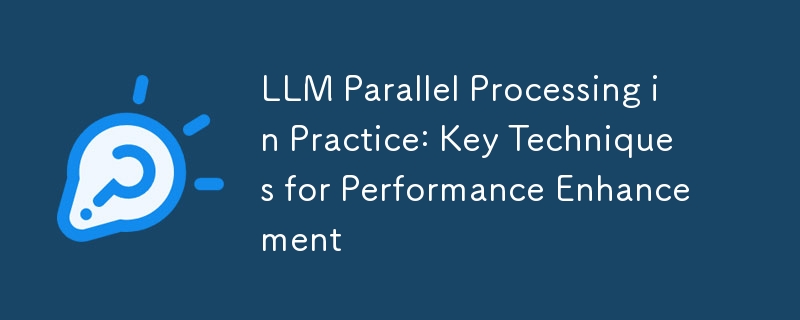LLM并行处理实践:性能增强的关键技术

要点
- 掌握LLM申请中的并行处理策略
- 实施高效的批处理机制
- 构建可扩展的文档处理系统
- 优化系统性能和资源利用率
并行处理用例
在LLM应用中,并行处理特别适合:
- 批量文档处理
- 多模型并行推理
- 大规模数据分析
- 实时流处理
批处理策略设计
1. 基本架构
from typing import List, Dict, Any
from dataclasses import dataclass
import asyncio
from langchain.chat_models import ChatOpenAI
from langchain.callbacks import AsyncCallbackHandler
@dataclass
class BatchConfig:
"""Batch processing configuration"""
batch_size: int = 5
max_concurrent_tasks: int = 3
timeout_seconds: int = 30
retry_attempts: int = 2
class BatchProcessor:
def __init__(self, config: BatchConfig):
self.config = config
self.llm = ChatOpenAI(
temperature=0,
request_timeout=config.timeout_seconds
)
self.semaphore = asyncio.Semaphore(
config.max_concurrent_tasks
)
async def process_batch(
self,
items: List[Any]
) -> List[Dict]:
"""Main batch processing function"""
batches = self._create_batches(items)
results = []
for batch in batches:
batch_results = await self._process_batch_with_semaphore(
batch
)
results.extend(batch_results)
return results
2. 异步处理实现
class AsyncBatchProcessor(BatchProcessor):
async def _process_single_item(
self,
item: Any
) -> Dict:
"""Process single item"""
async with self.semaphore:
for attempt in range(self.config.retry_attempts):
try:
return await self._execute_processing(item)
except Exception as e:
if attempt == self.config.retry_attempts - 1:
return self._create_error_response(item, e)
await asyncio.sleep(2 ** attempt)
async def _execute_processing(
self,
item: Any
) -> Dict:
"""Execute specific processing logic"""
task = asyncio.create_task(
self.llm.agenerate([item])
)
try:
result = await asyncio.wait_for(
task,
timeout=self.config.timeout_seconds
)
return {
"status": "success",
"input": item,
"result": result
}
except asyncio.TimeoutError:
task.cancel()
raise
真实案例:批量文档处理系统
1. 系统架构
class DocumentBatchProcessor:
def __init__(self):
self.config = BatchConfig(
batch_size=10,
max_concurrent_tasks=5
)
self.processor = AsyncBatchProcessor(self.config)
self.results_manager = ResultsManager()
async def process_documents(
self,
documents: List[str]
) -> Dict:
"""Process document batches"""
try:
preprocessed = await self._preprocess_documents(
documents
)
results = await self.processor.process_batch(
preprocessed
)
return await self.results_manager.merge_results(
results
)
except Exception as e:
return self._handle_batch_error(e, documents)
2. 资源控制机制
class ResourceController:
def __init__(self):
self.token_limit = 4096
self.request_limit = 100
self._request_count = 0
self._token_count = 0
self._reset_time = None
async def check_limits(self) -> bool:
"""Check resource limits"""
await self._update_counters()
return (
self._request_count < self.request_limit and
self._token_count < self.token_limit
)
async def track_usage(
self,
tokens_used: int
):
"""Track resource usage"""
self._token_count += tokens_used
self._request_count += 1
async def wait_if_needed(self):
"""Wait for resource release if necessary"""
if not await self.check_limits():
wait_time = self._calculate_wait_time()
await asyncio.sleep(wait_time)
3. 结果合并策略
class ResultsManager:
def __init__(self):
self.merge_strategies = {
"text": self._merge_text_results,
"embeddings": self._merge_embedding_results,
"classifications": self._merge_classification_results
}
async def merge_results(
self,
results: List[Dict]
) -> Dict:
"""Merge processing results"""
merged = {
"success_count": 0,
"error_count": 0,
"results": []
}
for result in results:
if result["status"] == "success":
merged["success_count"] += 1
merged["results"].append(
await self._process_result(result)
)
else:
merged["error_count"] += 1
return merged
性能优化指南
1. 内存管理
class MemoryManager:
def __init__(self, max_memory_mb: int = 1024):
self.max_memory = max_memory_mb * 1024 * 1024
self.current_usage = 0
async def monitor_memory(self):
"""Monitor memory usage"""
import psutil
process = psutil.Process()
memory_info = process.memory_info()
if memory_info.rss > self.max_memory:
await self._trigger_memory_cleanup()
async def _trigger_memory_cleanup(self):
"""Trigger memory cleanup"""
import gc
gc.collect()
2. 性能监控
class PerformanceMonitor:
def __init__(self):
self.metrics = {
"processing_times": [],
"error_rates": [],
"throughput": []
}
async def record_metrics(
self,
batch_size: int,
duration: float,
errors: int
):
"""Record performance metrics"""
self.metrics["processing_times"].append(duration)
self.metrics["error_rates"].append(errors / batch_size)
self.metrics["throughput"].append(
batch_size / duration
)
最佳实践
-
批处理优化
- 根据系统资源动态调整批量大小
- 实施智能重试机制
- 监控和优化内存使用情况
-
并发控制
- 使用信号量限制并发
- 实施请求速率限制
- 设置合理的超时值
-
错误处理
- 实施分层错误处理
- 记录详细的错误信息
- 提供优雅的降级选项
性能调整点
-
系统级
- 监控系统资源使用情况
- 优化内存管理
- 实施负载平衡
-
应用级别
- 优化批处理策略
- 调整并发参数
- 实施缓存机制
概括
并行处理对于构建高性能 LLM 应用程序至关重要。要点:
- 设计高效的批处理策略
- 实施强大的资源管理
- 监控和优化系统性能
- 优雅地处理错误
以上是LLM并行处理实践:性能增强的关键技术的详细内容。更多信息请关注PHP中文网其他相关文章!

热AI工具

Undresser.AI Undress
人工智能驱动的应用程序,用于创建逼真的裸体照片

AI Clothes Remover
用于从照片中去除衣服的在线人工智能工具。

Undress AI Tool
免费脱衣服图片

Clothoff.io
AI脱衣机

Video Face Swap
使用我们完全免费的人工智能换脸工具轻松在任何视频中换脸!

热门文章

热工具

记事本++7.3.1
好用且免费的代码编辑器

SublimeText3汉化版
中文版,非常好用

禅工作室 13.0.1
功能强大的PHP集成开发环境

Dreamweaver CS6
视觉化网页开发工具

SublimeText3 Mac版
神级代码编辑软件(SublimeText3)
 Python与C:学习曲线和易用性
Apr 19, 2025 am 12:20 AM
Python与C:学习曲线和易用性
Apr 19, 2025 am 12:20 AM
Python更易学且易用,C 则更强大但复杂。1.Python语法简洁,适合初学者,动态类型和自动内存管理使其易用,但可能导致运行时错误。2.C 提供低级控制和高级特性,适合高性能应用,但学习门槛高,需手动管理内存和类型安全。
 Python和时间:充分利用您的学习时间
Apr 14, 2025 am 12:02 AM
Python和时间:充分利用您的学习时间
Apr 14, 2025 am 12:02 AM
要在有限的时间内最大化学习Python的效率,可以使用Python的datetime、time和schedule模块。1.datetime模块用于记录和规划学习时间。2.time模块帮助设置学习和休息时间。3.schedule模块自动化安排每周学习任务。
 Python vs.C:探索性能和效率
Apr 18, 2025 am 12:20 AM
Python vs.C:探索性能和效率
Apr 18, 2025 am 12:20 AM
Python在开发效率上优于C ,但C 在执行性能上更高。1.Python的简洁语法和丰富库提高开发效率。2.C 的编译型特性和硬件控制提升执行性能。选择时需根据项目需求权衡开发速度与执行效率。
 学习Python:2小时的每日学习是否足够?
Apr 18, 2025 am 12:22 AM
学习Python:2小时的每日学习是否足够?
Apr 18, 2025 am 12:22 AM
每天学习Python两个小时是否足够?这取决于你的目标和学习方法。1)制定清晰的学习计划,2)选择合适的学习资源和方法,3)动手实践和复习巩固,可以在这段时间内逐步掌握Python的基本知识和高级功能。
 Python vs. C:了解关键差异
Apr 21, 2025 am 12:18 AM
Python vs. C:了解关键差异
Apr 21, 2025 am 12:18 AM
Python和C 各有优势,选择应基于项目需求。1)Python适合快速开发和数据处理,因其简洁语法和动态类型。2)C 适用于高性能和系统编程,因其静态类型和手动内存管理。
 Python标准库的哪一部分是:列表或数组?
Apr 27, 2025 am 12:03 AM
Python标准库的哪一部分是:列表或数组?
Apr 27, 2025 am 12:03 AM
pythonlistsarepartofthestAndArdLibrary,herilearRaysarenot.listsarebuilt-In,多功能,和Rused ForStoringCollections,而EasaraySaraySaraySaraysaraySaraySaraysaraySaraysarrayModuleandleandleandlesscommonlyusedDduetolimitedFunctionalityFunctionalityFunctionality。
 Python:自动化,脚本和任务管理
Apr 16, 2025 am 12:14 AM
Python:自动化,脚本和任务管理
Apr 16, 2025 am 12:14 AM
Python在自动化、脚本编写和任务管理中表现出色。1)自动化:通过标准库如os、shutil实现文件备份。2)脚本编写:使用psutil库监控系统资源。3)任务管理:利用schedule库调度任务。Python的易用性和丰富库支持使其在这些领域中成为首选工具。
 科学计算的Python:详细的外观
Apr 19, 2025 am 12:15 AM
科学计算的Python:详细的外观
Apr 19, 2025 am 12:15 AM
Python在科学计算中的应用包括数据分析、机器学习、数值模拟和可视化。1.Numpy提供高效的多维数组和数学函数。2.SciPy扩展Numpy功能,提供优化和线性代数工具。3.Pandas用于数据处理和分析。4.Matplotlib用于生成各种图表和可视化结果。






